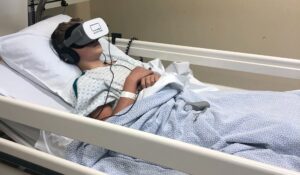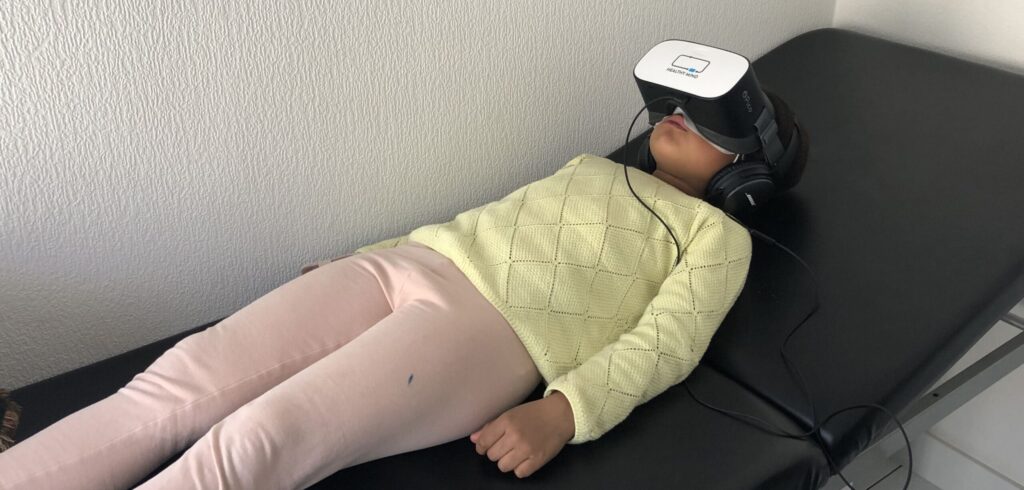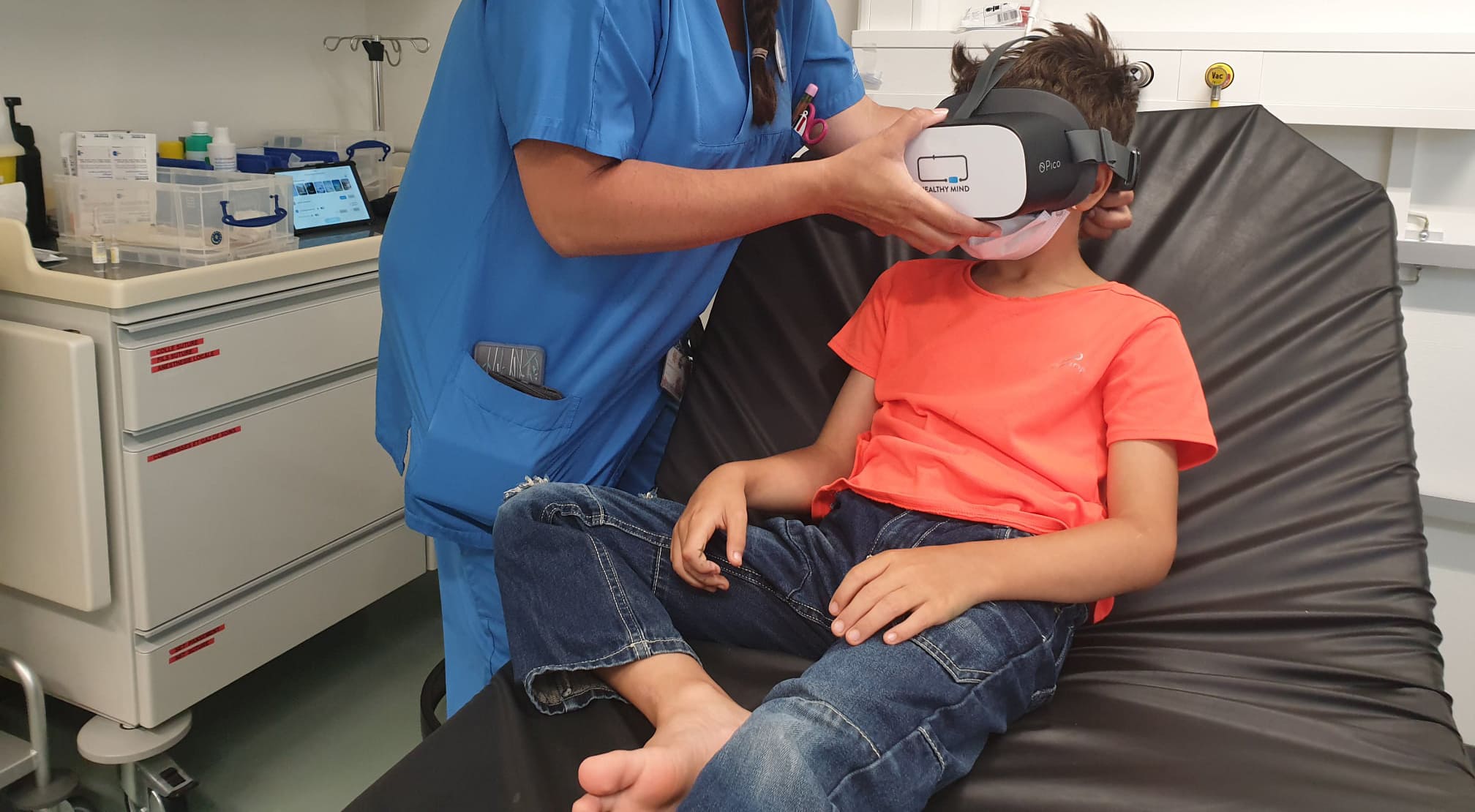A child’s hospitalisation is accompanied by stress for the patient, as well as for the parents. The fear of the unknown is added to the fear of being in pain, of being separated from their loved ones or of having postoperative discomforts from the operation. However, this natural anxiety is not to be taken lightly, as it can lead to complications such as postoperative pain or increased doses of painkillers. Virtual reality in paediatrics offers a playful method to calm little patients’ fears during an anxiety-provoking or painful medical procedure. How does it work and what are the advantages of using it? In this article, we detail all the benefits of VR for paediatric patients.
What are the concerns of a child before a treatment or an examination?
Most children feel anxious when they come into contact with the medical and hospital world. The image of the hospital conveyed by the media and adults does not always help young children to feel reassured. Indeed, the universe described seems hostile and the events that take place there always seem frightening, dramatic and painful.
Generally, children are not familiar with the hospital atmosphere, its environment, its language and its professionals, so the gestures, the setting and the machines they discover seem surprising and confusing. Faced with a mysterious operation, the child gets lost in an organisation of care, the common thread of which he or she does not clearly grasp.
In addition to all these unknowns, the youngest children are also afraid of the traces that the interventions leave on them. Sometimes, the child constructs erroneous representations of the consequences of medical procedures and can thus imagine that a wound will never close, that he or she will not wake up from an anaesthetic or that he or she will be pierced by X-rays…
Finally, the fear of being hurt, even if it’s not always expressed, exists in children. This anxiety will be all the more acute if the child doesn’t understand the reason for the treatment or if a previous experience has had a negative impact on his or her memory. Fortunately, there are solutions to effectively relieve children’s pain and stress in hospitals.

The advantages of virtual reality in paediatrics
1. An intuitive, accessible and attractive system for young people
As we have just seen, the hospital environment conveys negative preconceptions. The proposal of a game and immersion in virtual reality offers a welcome escape for children. Rather than focusing on an anxiety-provoking environment, they can concentrate on attractive visuals.
Although young people are increasingly aware of new technologies, they rarely have a VR headset at home. Thus, this experience is likely to arouse children’s curiosity and encourage their engagement.
The device of a therapeutic virtual reality immersion is based on the well-being of the patients and not on the appearance of additional ailments. As a result, the technology used by Healthy Mind limits cyberkinetosis, the virtual motion sickness, through the teleportation process of its virtual reality software.
Furthermore, the duration of the immersions is fully adjustable so that the recommendations concerning visual fatigue can be thoroughly followed.
2. A non-pharmacological device to reduce anxiety and pain
Procedures such as intravenous injections, repairing lacerations or changing dressings for burns are an integral part of paediatric medical treatment. Although sometimes necessary, pharmacological analgesics are not without side effects. Therefore, distraction is an important non-medicinal technique to manage and reduce the child’s anxiety about care.
Pain is an experience that contains sensory, cognitive, behavioural and psychological components. Passive distraction such as listening to a book or watching television and active distraction with games have been extensively studied and have been shown to reduce pain and anxiety. However, virtual reality offers a solution that is all the more effective because it completely immerses the patient and offers a multisensory experience.

As the study by Karen Arane, Amir Behboudi and Ran D Goldman states:
“Virtual reality does not interrupt pain signals, but acts directly and indirectly on pain perception and reporting through attention, emotion, concentration, memory and other senses.”
For example, a study by Hoffman and his colleagues using functional magnetic resonance imaging with patients using virtual reality while exposed to a painful stimulus showed a more than 50% reduction in pain-related brain activity in 5 areas of the brain.
A literature review analysing data from 5 studies shows the effectiveness of virtual reality in reducing pain, especially its intensity, in burned children and adolescents. Another study by Gershon and his colleagues focused on patients with childhood cancer (leukaemia, lymphoid, solid mass) for whom a venous access port was installed as part of their ontological therapy. It was observed with three different assessments that the children’s anxiety and pain levels decreased when virtual reality was used.
3. A light and programmable device adapted to the hospital context
For a long time, the use of virtual reality has been limited by its purchase cost. However, recent technological advances have reduced the cost of VR equipment, making it more accessible. In addition, the initial investment pays quickly for itself because of the many use cases for which the device can be used. If you are not yet convinced by the purchase, there is a rental solution that allows you to test the equipment before committing to a longer period.
The device isn’t intended to establish a distance from the caregivers, which is why they don’t disappear from the child’s environment during the immersion. In fact, the medical staff can communicate with the young patient at any time by means of vocal or visual messages. Moreover, the experience remains entirely modular so that it can be adapted to the modalities of each intervention.

Healthy Mind’s paediatric environment: a solution specifically designed for children
In general, Healthy Mind environments incorporate hypnotic speech, breathing exercises, and a soothing sound atmosphere to reduce patients’ pain and anxiety. While the benefits of hypnosis are well established, the use of music therapy also helps to reduce the anxiety and pain associated with painful procedures, as this study shows.
To go further in the support of young patients, we have designed an environment especially for them: the magic archipelago. This immersion shows an enchanting landscape and childlike visuals to capture their attention. To further stimulate the children’s curiosity, animals and specific visual stimuli have been designed along the way.
The therapeutic journey includes quests on three islands to help little patients escape and have fun. Thus, this relaxation tool proposes an active participation of the child during the treatment so that he or she is immersed in an adventure in which he or she will be the main protagonist.
Children need a reassuring presence to stay by their side throughout the intervention. To show this support and encouragement, Captain Cool, a cheerful and colourful parrot, accompanies the young patients every step of the way with continuous words of comfort.
Among the methods of distraction, paediatric virtual reality offers an effective non-drug solution through a multi-sensory experience. The non-invasive, autonomous and customisable device adapts to the conditions of hospitalisation and the modalities of each intervention. By reducing pain and anxiety, the immersions offer a more calming and comfortable care experience for young patients. If you would like to see a demonstration or get more information, please contact our team, we will be happy to help!
Sources :
- Sparadrap, Children’s anxieties before care, examination…;
- Canadian Paediatric Society, Managing pain and distress in children undergoing brief diagnostic and therapeutic procedures;
- Hoffman HG, Richards TL, Coda B, Bills AR, Blough D, Richards AL, Sharar SR. Modulation of thermal pain-related brain activity with virtual reality: evidence from fMRI. Neuroreport. 2004 Jun 7;15(8):1245-8. doi: 10.1097/01.wnr.0000127826.73576.91. PMID: 15167542;
- Ines Villa. Efficacy of virtual reality in pain management in burned children and adolescents. Human medicine and pathology. 2021. dumas-03359293;
- Gershon J, Zimand E, Pickering M, Rothbaum BO, Hodges L. A pilot and feasibility study of virtual reality as a distraction for children with cancer. J Am Acad Child Adolesc Psychiatry. 2004 Oct;43(10):1243-9. doi: 10.1097/01.chi.0000135621.23145.05. PMID: 15381891;
- Arane K, Behboudi A, Goldman RD. Virtual reality for pain and anxiety management in children. Can Fam Physician. 2017 Dec;63(12):935-937. French. PMID: 29237633; PMCID: PMC5729141.







